
How to Use WeAct I2S Stereo Speaker Modul PCM5100A Dual PA 4Ω 2,8W ClassD: Examples, Pinouts, and Specs
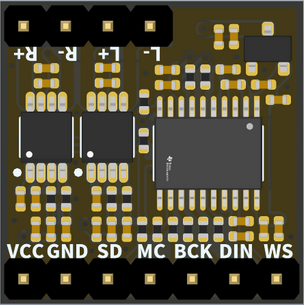
 Design with WeAct I2S Stereo Speaker Modul PCM5100A Dual PA 4Ω 2,8W ClassD in Cirkit Designer
Design with WeAct I2S Stereo Speaker Modul PCM5100A Dual PA 4Ω 2,8W ClassD in Cirkit DesignerIntroduction
The WeAct I2S Stereo Speaker Modul PCM5100A Dual PA 4Ω 2.8W ClassD (Manufacturer Part ID: I2S Speaker Modul V1) is a high-quality stereo speaker module designed for audio applications requiring I2S digital audio input. It features the PCM5100A Digital-to-Analog Converter (DAC) for superior audio quality and includes dual Class-D power amplifiers capable of delivering up to 2.8W per channel at 4Ω impedance. This module is ideal for compact audio systems, DIY audio projects, and embedded systems requiring high-fidelity sound output.
Explore Projects Built with WeAct I2S Stereo Speaker Modul PCM5100A Dual PA 4Ω 2,8W ClassD
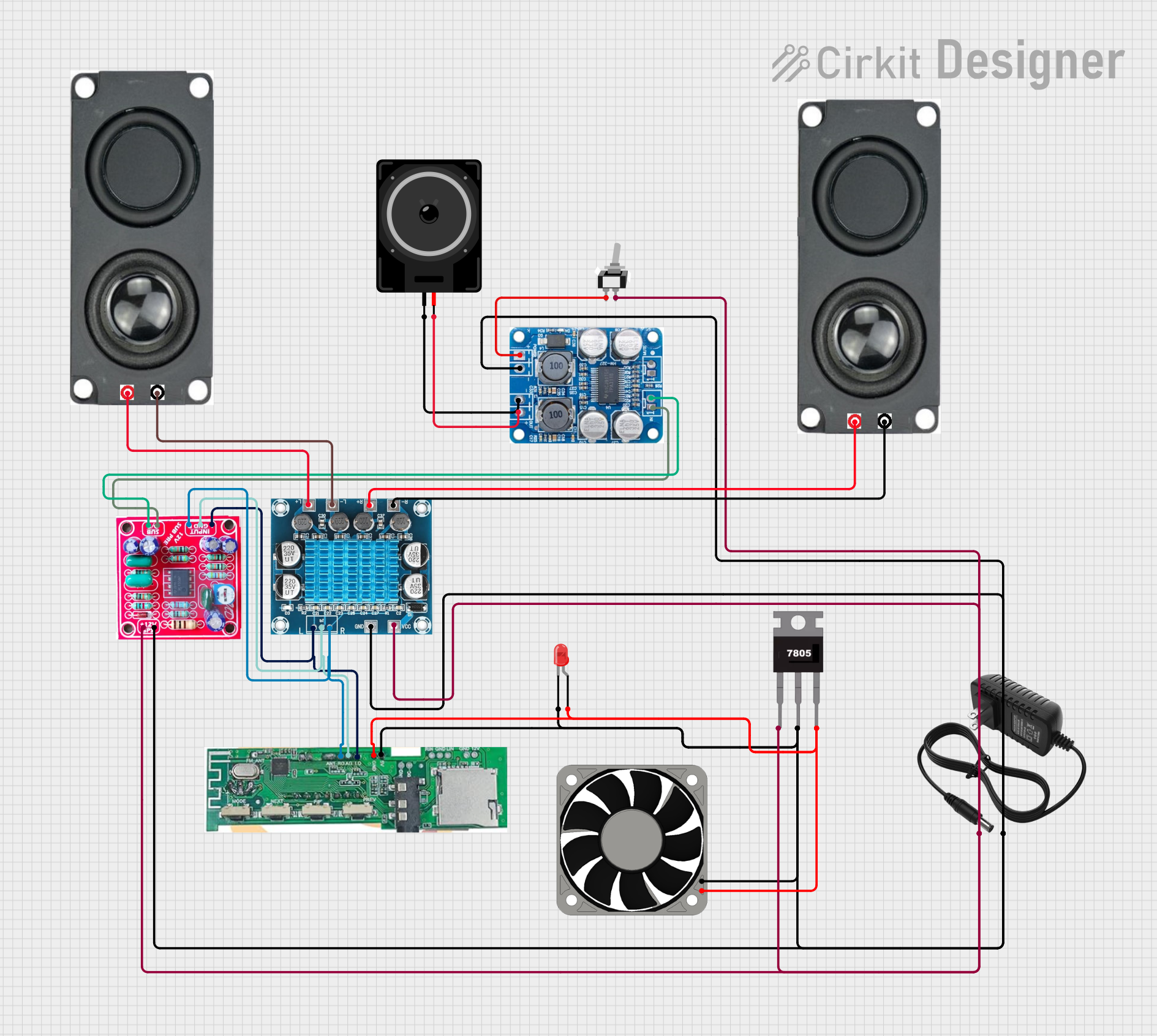
 Open Project in Cirkit Designer
Open Project in Cirkit Designer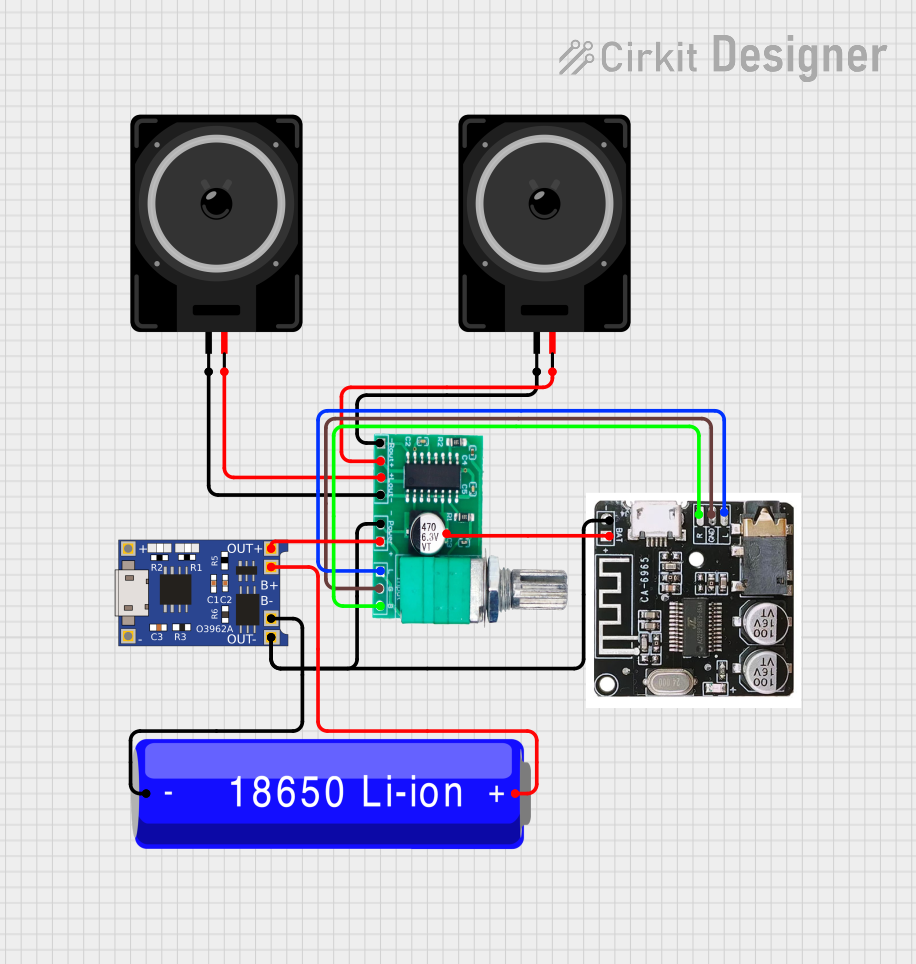
 Open Project in Cirkit Designer
Open Project in Cirkit Designer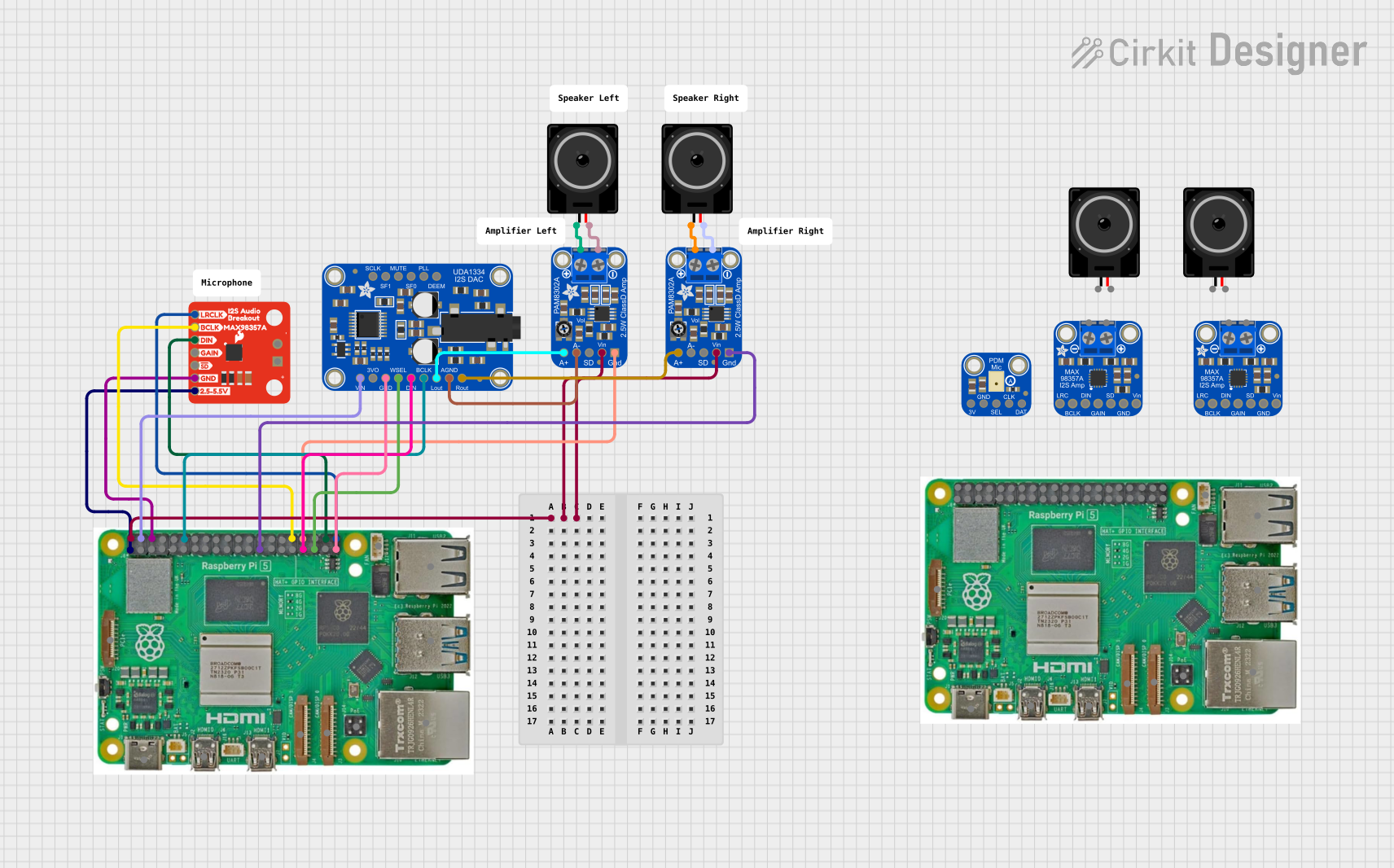
 Open Project in Cirkit Designer
Open Project in Cirkit Designer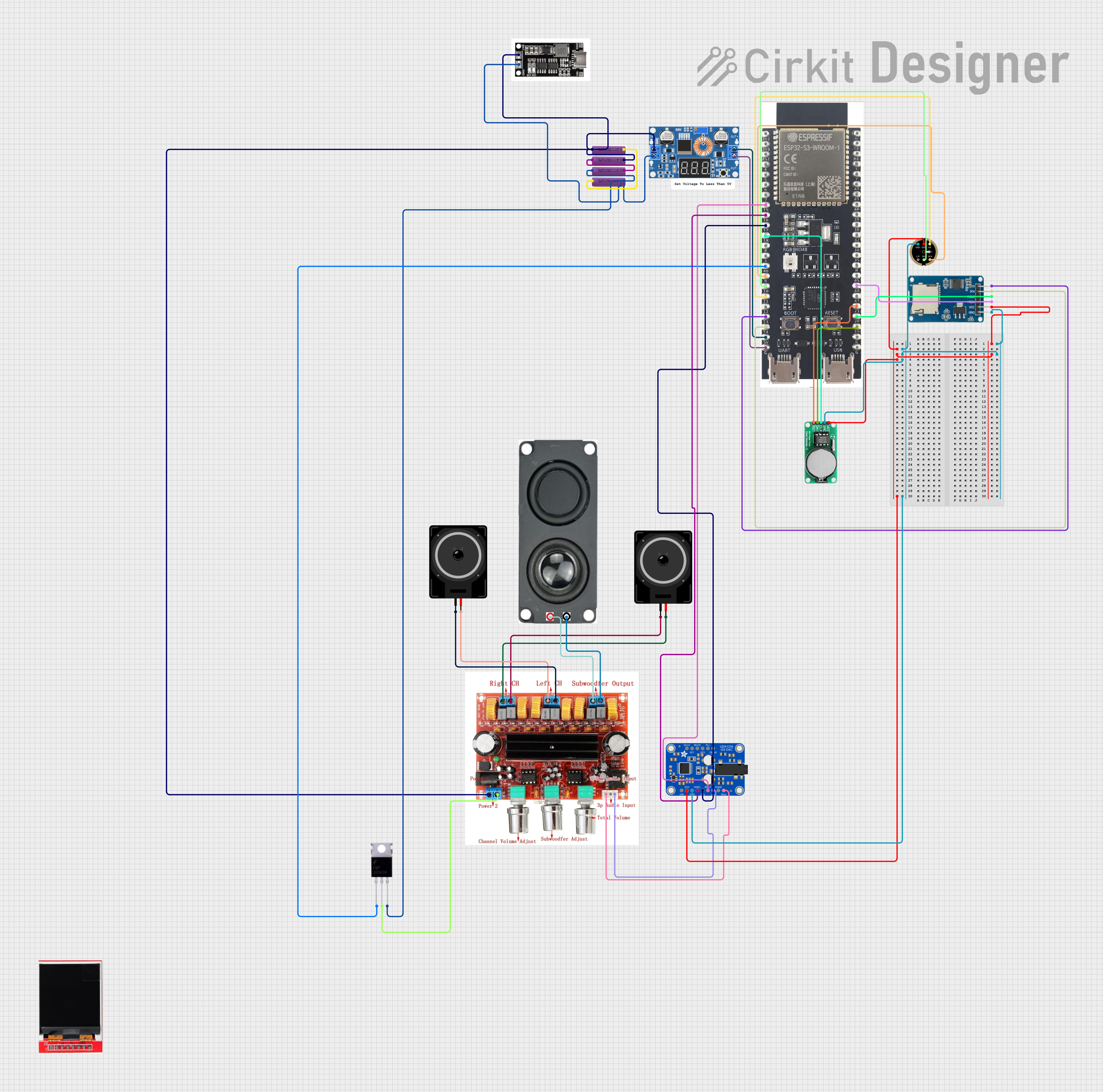
 Open Project in Cirkit Designer
Open Project in Cirkit DesignerExplore Projects Built with WeAct I2S Stereo Speaker Modul PCM5100A Dual PA 4Ω 2,8W ClassD

 Open Project in Cirkit Designer
Open Project in Cirkit Designer
 Open Project in Cirkit Designer
Open Project in Cirkit Designer
 Open Project in Cirkit Designer
Open Project in Cirkit Designer
 Open Project in Cirkit Designer
Open Project in Cirkit DesignerCommon Applications
- DIY audio systems and portable speakers
- Embedded systems with I2S audio output
- Smart home devices with audio playback
- Educational projects and prototyping
- Audio output for microcontrollers like Arduino, ESP32, and Raspberry Pi
Technical Specifications
Key Technical Details
| Parameter | Value |
|---|---|
| DAC Chip | PCM5100A |
| Amplifier Type | Class-D |
| Output Power | 2.8W per channel (at 4Ω load) |
| Input Interface | I2S (Inter-IC Sound) |
| Supported Sampling Rates | 8kHz to 384kHz |
| Output Impedance | 4Ω |
| Power Supply Voltage | 5V DC |
| Dimensions | 30mm x 30mm |
Pin Configuration and Descriptions
The module has a total of 7 pins for power, I2S input, and speaker output. The pinout is as follows:
Input and Power Pins
| Pin Name | Type | Description |
|---|---|---|
| VIN | Power | 5V DC power input |
| GND | Ground | Ground connection |
| BCK | Input | I2S bit clock |
| LRCK | Input | I2S left-right clock |
| DIN | Input | I2S data input |
Output Pins
| Pin Name | Type | Description |
|---|---|---|
| SPK_L+ | Output | Positive terminal for left speaker |
| SPK_L- | Output | Negative terminal for left speaker |
| SPK_R+ | Output | Positive terminal for right speaker |
| SPK_R- | Output | Negative terminal for right speaker |
Usage Instructions
How to Use the Component in a Circuit
- Power Supply: Connect the VIN pin to a stable 5V DC power source and the GND pin to ground.
- I2S Input: Connect the BCK, LRCK, and DIN pins to the corresponding I2S output pins of your microcontroller or audio source.
- Speaker Connection: Attach the left speaker to SPK_L+ and SPK_L-, and the right speaker to SPK_R+ and SPK_R-. Ensure the speakers have a 4Ω impedance for optimal performance.
- Audio Playback: Send I2S audio data from your microcontroller or audio source to the module. The PCM5100A DAC will convert the digital signal to analog, and the Class-D amplifiers will drive the connected speakers.
Important Considerations and Best Practices
- Power Supply: Use a clean and stable 5V power source to avoid noise in the audio output.
- Speaker Impedance: Ensure the connected speakers have a 4Ω impedance to match the amplifier's specifications.
- Heat Dissipation: Although the module is efficient, ensure proper ventilation to prevent overheating during prolonged use.
- I2S Configuration: Configure your microcontroller's I2S interface to match the module's requirements (e.g., bit depth, sampling rate).
Example: Connecting to an Arduino UNO
The Arduino UNO does not have native I2S support, but you can use an external I2S interface or switch to a microcontroller like the ESP32. Below is an example of using the ESP32 to send audio data to the module:
#include <Arduino.h>
#include <I2S.h>
// I2S pin definitions for ESP32
#define I2S_BCK 26 // Bit clock pin
#define I2S_LRCK 25 // Left-right clock pin
#define I2S_DIN 22 // Data input pin
void setup() {
// Initialize I2S in master mode
if (!I2S.begin(I2S_PHILIPS_MODE, 44100, 16)) {
Serial.println("Failed to initialize I2S!");
while (1); // Halt if I2S initialization fails
}
// Set I2S pin configuration
I2S.setPins(I2S_BCK, I2S_LRCK, I2S_DIN);
Serial.println("I2S initialized successfully.");
}
void loop() {
// Example: Send a simple sine wave to the speaker module
static float phase = 0.0;
const float frequency = 440.0; // Frequency of the sine wave (A4 note)
const float amplitude = 32767.0; // Max amplitude for 16-bit audio
const float sampleRate = 44100.0; // Sampling rate in Hz
// Generate a sine wave sample
int16_t sample = (int16_t)(amplitude * sin(phase));
phase += 2.0 * PI * frequency / sampleRate;
if (phase >= 2.0 * PI) phase -= 2.0 * PI;
// Write the sample to the I2S output
I2S.write(sample);
}
Troubleshooting and FAQs
Common Issues and Solutions
No Sound Output
- Check Connections: Ensure all pins are connected correctly, especially the I2S input and speaker terminals.
- Verify Power Supply: Confirm that the module is receiving a stable 5V DC supply.
- I2S Configuration: Double-check the I2S settings on your microcontroller (e.g., bit depth, sampling rate).
Distorted Audio
- Speaker Impedance: Ensure the connected speakers have a 4Ω impedance.
- Power Supply Noise: Use a clean power source to minimize noise and distortion.
- Overdriving the Amplifier: Avoid sending excessively high audio levels to prevent clipping.
Overheating
- Ventilation: Ensure proper airflow around the module.
- Speaker Load: Verify that the speakers meet the module's specifications.
FAQs
Can I use 8Ω speakers with this module?
- Yes, but the output power will be reduced, and the audio quality may be affected.
What microcontrollers are compatible with this module?
- Any microcontroller with I2S support, such as ESP32, Raspberry Pi, or STM32, can be used.
Can I use this module with a battery-powered system?
- Yes, as long as the battery provides a stable 5V output.
What is the maximum sampling rate supported?
- The module supports sampling rates up to 384kHz.
This documentation provides a comprehensive guide to using the WeAct I2S Stereo Speaker Modul PCM5100A Dual PA 4Ω 2.8W ClassD. For further assistance, refer to the manufacturer's datasheet or contact technical support.